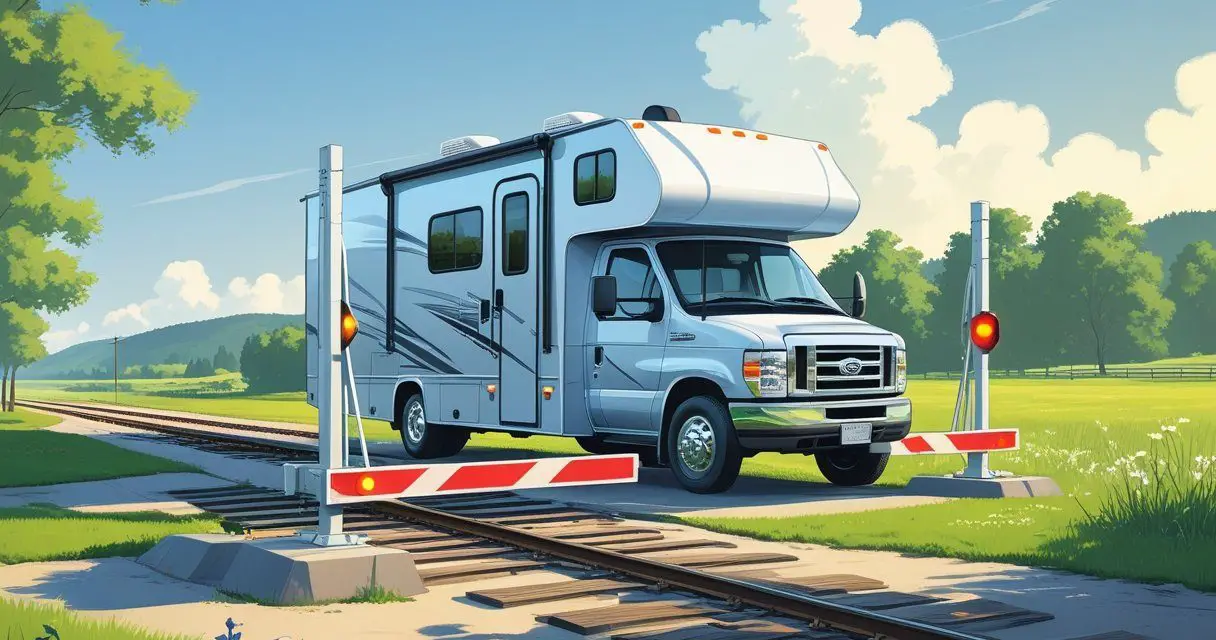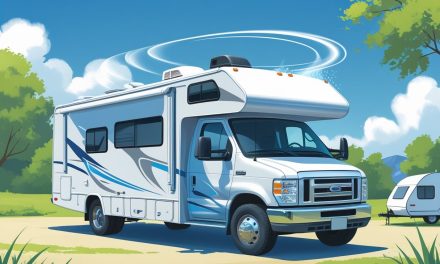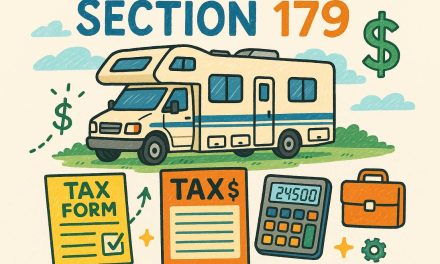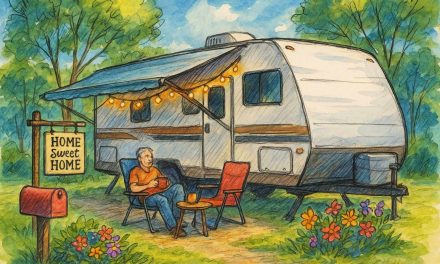Would you like to save this article?
You’re cruising down the highway in your dream RV, windows down, music playing, living your best nomadic life. Suddenly, you spot those familiar railroad crossing signs ahead. Most RVers roll right over those tracks without a second thought – but what you don’t know about railroad crossings could literally be a matter of life and death.
According to Operation Lifesaver, every 3 hours in the United States, a vehicle or person is hit by a train. That’s 8 collisions every single day! Even more startling? Over half of these collisions happen at crossings equipped with lights and gates, meaning drivers are actively ignoring or underestimating the warning systems designed to protect them.
As RVers, you’re driving vehicles that are longer, heavier, and slower than typical cars – making you especially vulnerable to these deadly encounters.
1. Your RV is a 30,000-Pound Sitting Duck (And Trains Don’t Care)
Here’s something that might blow your mind: that “small” Class A motorhome you’re driving can weigh up to 30,000 pounds when fully loaded. Compare that to the average passenger car at around 4,000 pounds, and you’re essentially driving a small building down the highway. But here’s the kicker – while your RV might feel massive and unstoppable, it’s absolutely nothing compared to a freight train.
The average freight train weighs between 12 to 20 million pounds and often pulls around 100 cars. To put this in perspective, your 30,000-pound RV is 400-600 times lighter than the train barreling down those tracks. When a train traveling at 55 mph hits the brakes, it can take over a mile to come to a complete stop – that’s nearly 18 football fields!
| Vehicle Type | Average Weight | Stopping Distance at 55 mph |
|---|---|---|
| Passenger Car | 4,000 lbs | 300-400 feet |
| Class A RV | 20,000-30,000 lbs | 400-500 feet |
| Freight Train | 12-20 million lbs | 5,280+ feet (1+ mile) |
You might think your massive RV gives you some protection, but physics doesn’t negotiate. When an unstoppable force meets a movable object, guess which one wins?
2. That Optical Illusion is Literally Playing Tricks on Your Brain
Ever wonder why so many people think they have “plenty of time” to beat a train across the tracks? Your brain is being hijacked by a deadly optical illusion. A locomotive stands about 17 feet high and 10 feet wide – when viewed from an angle at a crossing, this massive object actually appears to be moving slower than it really is.
The parallel rails create what experts call “size-distance misjudgment,” making trains seem further away than they actually are. Modern trains are also surprisingly quiet, especially compared to the rumbling diesel beasts of decades past. You literally cannot trust your eyes and ears when it comes to judging a train’s speed and distance.
According to Federal Railroad Administration statistics, 2,260 highway-rail grade crossing collisions occurred in 2024, resulting in 261 fatalities and 762 injuries. Many of these accidents happen because drivers genuinely believe they have enough time to cross safely.
You’ve probably made this exact mistake before – seeing a train in the distance and thinking “I’ve got this.” Your brain is literally wired wrong for this situation, so don’t trust it with your life.
3. Your RV’s “Tail” Could Get You Killed (Even When You Think You’re Safe)
Here’s a terrifying fact most RVers never consider: even if your wheels clear the tracks, you might not be safe. Your RV’s rear end overhangs beyond the axle, sometimes by several feet. That fancy bike rack, spare tire, or rear storage compartment could still be in the train’s path even after your wheels have crossed.
Operation Lifesaver recommends at least 15 feet of clearance between the rear of your vehicle and the furthest rail before you even start crossing. For a 40-foot Class A motorhome, you need to ensure there’s enough space for:
- 40 feet for your RV length
- 15 feet minimum clearance buffer
- Total: 55 feet of clear space on the far side
But wait, there’s more! If you’re towing a vehicle or trailer, add that length plus another 15-foot buffer. A 40-foot motorhome towing a 20-foot car could need 75+ feet of clear road on the other side of the tracks.
You know what’s really scary? Most drivers never calculate this. They see a gap between cars at the traffic light ahead and think “that’s enough” without ever doing the math.
4. Your RV Could Get “High-Centered” and Become a Train Magnet
Picture this nightmare scenario: You’re following your GPS through rural America when it routes you over a “humped” railroad crossing – tracks that sit on a raised bed higher than the roadway. Your RV’s long wheelbase and low ground clearance cause it to bottom out on the rails, leaving you stuck directly in a train’s path.
This isn’t some far-fetched movie scenario – it happens more often than you think. The video creator shared his own near-miss experience driving a converted school bus through rural Mississippi, where he felt “the sickening scrape of the bus’s undercarriage on the rails.” He was lucky his bus had high ground clearance and a protective skid bar.
Class A motorhomes with low air ride suspension are particularly vulnerable to high-centering. These crossings are marked with “High Profile Vehicle” warning signs, but many drivers either miss them or don’t understand what they mean.
If your RV gets stuck on railroad tracks, Operation Lifesaver says you should:
- Get everyone out immediately and move far away
- Find the blue and white Emergency Notification System (ENS) sign
- Call the number and provide the crossing’s DOT ID number
- If no sign is visible, call 911
You’d rather spend money on a longer route than risk becoming a statistic because you trusted your GPS over common sense.
5. Over Half of Train Crashes Happen Where There Are Working Warning Lights
This might be the most shocking statistic of all: Over 50% of vehicle-train collisions occur at crossings equipped with automatic signals like flashing lights and gates. These aren’t accidents caused by malfunctioning equipment – they’re caused by drivers who choose to ignore the warnings.
Some drivers suffer from “normalcy bias” – they cross the same tracks daily without seeing a train, so they become complacent. Others are distracted by music, conversations, or mobile devices. But here’s the most disturbing part: In about 25% of crashes, the vehicle actually runs into the side of the train, often because drivers are traveling too fast or can’t see properly at night.
The Federal Railroad Administration data shows that highway-rail grade crossing collisions and pedestrian trespassing together account for over 95% of all railroad fatalities. Since 2017, all 212,000 railroad crossings in the U.S. have been marked with identification signs, yet people keep getting hit.
Why do smart people make such deadly decisions? Because you start thinking “I’ve beaten trains before” or “I know this crossing” or “That train is moving slow.” Every single person who’s ever been hit by a train probably thought the exact same thing moments before impact.
The Bottom Line: Treat Every Crossing Like Your Life Depends on It
Railroad crossing safety isn’t just about following rules – it’s about understanding physics, psychology, and the deadly combination of massive momentum and human overconfidence. Your RV might be your home on wheels, but it’s no match for millions of pounds of steel moving at 55+ mph.
Remember these key facts:
- Trains cannot stop quickly – it takes over a mile at highway speeds
- Your brain will trick you about train speed and distance
- You need way more clearance than you think (minimum 15 feet + RV length)
- High-profile crossings can trap your RV on the tracks
- Most accidents happen at protected crossings because drivers ignore warnings
The next time you see those railroad crossing signs, slow down, calculate your clearance needs, and respect the physics. Because in the battle between your RV and a freight train, there’s only one possible winner – and it’s not you.
SOURCES
- Operation Lifesaver – Track Statistics
- Operation Lifesaver – Collisions & Fatalities by State
- National Safety Council – Railroad Crossing Safety
- RV Miles YouTube Channel – What Every RV Owner Needs To Know About Train Crossings
- GoDownsize – How Much Does Class A RVs Weigh
- RVshare – RV Dimensions Explained
- Association of American Railroads – Freight Rail Facts & Figures





